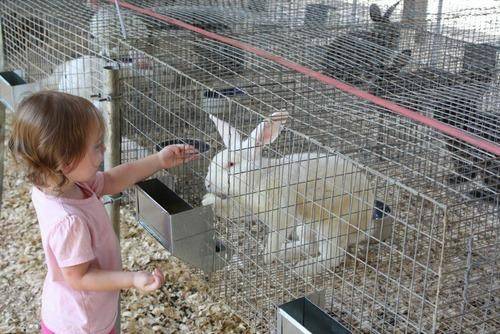
Rabbit feeding board is on the edge of the welded wire mesh cage.
After years’ experience and experiment of keeping rabbits, we design a kind of rabbit cage made from galvanised welded wire mesh which spends less and is firm enough and suitable for both summer and winter. This rabbit cage doesn’t need too much money and labor to manage. It’s worth marketing!
The structure design
The rabbit cage is made of brick, cement board, bamboo strips, welded wire mesh and iron wire. There are feeding board, grass basket and automatic design for urine and feces. The rabbit shed can be arranged for two rows rabbit stables on the east and west. The top of the cage is supported by the purline and put with corn stalk and sorghum stalk. With a layer of straw on it then sealing up the top with the mud and finally putting the tiles on it. Both sides of the rabbit shed are installed glass doors and there are ventilation holes left. A disinfection tank is prepared on the door. To prevent the mosquitoes and flies, insect screen is arranged on the cage door. The materials of the insect screen can be chosen for nylon, plastic or fiberglass.
The dimension design
The length of the rabbit cage is 40–60 cm, the height is 35–40 cm and the width is 50 cm. The last layer is 20–30 cm far away from the floor. The feeding board is 20 cm width and 46–66 cm length. Four holes of 0.5 cm are left on the cement board to arrange the welded wire mesh. The feces board is 46–66 cm length, 55 cm width and the thickness is 4–5 cm. There are four holes of 0.5 cm on the edge. The behind board is 46–66 cm length, 30–35 cm height and the thickness is 4–5 cm, at the same time, four holes are left on it. There are two kinds of bamboo plates design, one is flexible and the size is as the same as the rabbit cage. Another is fastened to the brick gap that is on the end of the cage. The first bamboo plate design is flexible while the second one is sturdy.
The welded wire mesh is 40–60 cm length and 35–40 cm width and we need cut the welded wire mesh according the actual dimensions.
The building requires
Normally the wall of the last layer is built with double bricks but we also use the single brick when the wall is cement and sand. The feces board should be reserved when the wall is built on the certain position. The feeding board is installed into the cage for 5 cm. The wall on the board should be fastened by the bricks. To support the back cement board the back wall indents to the wall for 3 cm and is built with simple bricks. The height of the cage is flexible from 30 cm to 40 cm.
When the two cement boards are installed, two 0.2–0.3 cm iron wires should be installed on the front and back of the wall on the height of 10 cm and 30 cm. And the iron wires should be 20 cm longer than the wall so that it’s easy to fasten the welded wire mesh.
When the rabbit cage is built, the brick gap and the cement board gap should be added with cement or lime. It’s to prevent that the rabbit’s hair is stick to the wall. The iron wires should stretch into the holes of the back cement board. The galvanised welded wire mesh is fastened on the cage and on the edge of the welded wire mesh is punched two holes. If you are not sure about the rabbit you would keep, you had better punch big holes for the adult rabbit and you can just add some iron wire meshes on the holes when you are going to keep the small rabbits. Because of the small front cage area, the hole should be punched on the cage door so that the rabbit can eat from the hole. The welded wire mesh is cut for 20 cm on the upper left cage and twists to 45°. The twisted space is added with iron wire meshes at intervals of 3 cm. After fastening the top edge, the grass basket is the V shaped. This grass basket is designed according to the quantity of rabbits and the space of the welded wire mesh. The welded wire mesh can service for almost five years and when it break down you can just change a new welded wire mesh panels.